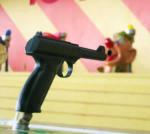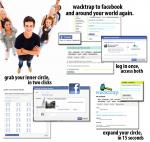What’s your story?
Share and find customer experiences
Connect with the people behind them
Wacktrap is
feedback made social
Trending Content
Tell All Says Bill Clinton Lost Nuke Codes as US President
by hearit
Good thing the U.S. didn’t want to nuke anyone around the year 2000. The top-secret codes that allowed the President of the United States to launch a nuclear attack were, well, (kinda, sorta) missing. It seems stuff, like codes, just (kinda, sorta) got lost—meaning the President couldn’t get a grasp on the “football” and, well, it’s just a good thing that things worked out. Or, rather, worked out again--President Carter lost the codes first.
It seems the codes—required by the President to initiate any nuclear attack--got lost for months around 2000. How long were those codes missing? Well, that’s (kinda, sorta) unclear too.
A former Joint Chiefs chairman Hugh Shelton has just published a new book, interestingly named, "Without Hesitation". Shelton’s new book seems to be at least a bit of a “tell-all”: apparently, the United States government would have had nothing but hesitation as its option, at least during the 2000 timeframe of Shelton’s government career under Clinton.
The retired General Hugh Shelton wrote, "Even though movies may show the president [of the U.S.] wearing these [nuclear] codes around his neck, it's pretty standard that they [the codes] are safeguarded by one of his [presidential] aides, but that aide sticks with him like glue."
President Bill Clinton "assumed, I'm sure, that the aide had them like he was supposed to,” and Shelton says President Clinton was probably unaware of the “problem”.
"The [nuclear activation] codes were actually missing for months," Shelton says. "We [the United States] dodged a silver bullet."
What apparently went missing was a card—a very “special” card, which contained code numbers allowing the United States President access a briefcase (aka, the "football") always kept by a presidential aide close at hand, and containing instructions for launching a nuclear attack. Somewhere during a month around 2000, when it was time to replace the nuclear attack codes with new ones, Clinton’s aide admitted that the codes had completely disappeared.
It’s hard to tell which is worse: the fact that the U.S. government was missing codes required in order to launch any nuclear attack—or the grade school slash “Get Smart” scenario that actually surrounds such an instance: our U.S. President needs a code to “access” a briefcase, and that briefcase is called the “football”? What, exactly, does that make the United States President?—perhaps the “kicker”?
Nuclear codes are printed on a credit-card-sized certificate, designed to allow the U.S. President to open a special briefcase with specific instructions for a surprise nuclear launch. The Commander-in-Chief is supposed to keep the card on him at all times—and, apparently, a presidential aide constitutes “on him”.
Once per month, the military verifies that the U.S. President has the right codes for any nuclear attack. At least twice in a row, Shelton says, a presidential aide told the “checker” that Clinton was in a meeting but assured him that the President had the nuclear codes.
Most likely none of the world would have the opportunity to question lost codes now, had a nuclear attack been initiated by any country at the turn of the century, but the reality is still frightening—even a decade later.
“Callbacks” may be no fun, but perhaps the Pentagon should have been a little more up on that one—like physically getting the President on the phone instead of taking someone else’s “word”.
Retired Air Force Lt. Colonel Robert Patterson recounted a similar story, seven years ago, when his own book was published—but with a slight variation of events. Patterson says he was one of the men who carried the “football”, and that it wasn’t lost by a presidential aide: President Bill Clinton himself, claims Patterson, “dropped the ball”.
The “football” apparently has a second nickname: the “biscuit”.
Patterson claims that discovery of the missing nuke card occurred the morning after the Monica Lewinsky scandal—involving Clinton as a key player in the scandalous mishap—had broken in the media. The U.S. general claims that he made a routine request—asking President Clinton to physically present the card containing the nuclear codes, so that Patterson could swap the card out for an updated version.
"He [President Clinton] thought he just placed them [the carded codes] upstairs," Patterson recalled. "We called upstairs, we started a search around the White House for the [nuclear] codes, and he finally confessed that he [the President] in fact misplaced them. He couldn't recall when he had last seen them."
To be fair, President Clinton did have a lot on his mind in those days with of that activity in the Oval Office.
In Patterson's version of the nuclear codes story, President Clinton himself lost the “biscuit” in 1998, while Shelton says the card went missing in 2000. It appears those missing “months” may have actually been years. It’s been said that President Jimmy Carter left his “biscuit” in a suit that ended up at a dry cleaners.
The “biscuit” seems to be increasing in size after the age of Carter and his suit pocket: since the “football” got dropped, perhaps the White House should consider the “elephant” for this round—a marked increase in size, and memory.
SPEED UP YOUR ONLINE GROWTH
How To Wack
Take the Tour
Click on any image to start












